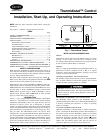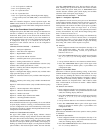
humidity removal is desired, this should be done, if possible. Fan
coils have the capability of removing this off delay, furnaces do
not. On FK or FV Fan Coils, set delay tap to 0/0. On standard fan
coils, a jumper can be cut to disable off delay. Refer to fan coil
Installation Instructions for details. If FAN is set for continuous
operation (fan ON icon displayed), G output is turned off for 5
minutes at the end of each cooling cycle as long as dehumidify
demand exists.
Like humidify, dehumidify actions are initiated when humidity is
2 percent above set point and are terminated when humidity drops
to 2 percent below set point. This prevents unnecessary toggling of
dehumidify actions when humidity is near set point.
The vacation mode contains additional dehumidify features de-
signed to protect an unoccupied home. Refer to the "Vacation"
section for additional information.
With any dehumidify selection, if the system has a 2-speed
compressor (DIP switch No. 2 is ON) and does NOT have a
variable-speed blower (Configuration Option No. 5 set to OFF), all
cooling will be done at high speed while dehumidify demand
exists. This is because the combination of 2-speed compressor
without variable-speed blower generally has poor water removal
on low speed.
Dehumidify Output and Equipment Connections
When there is a dehumidify demand, dehumidify output is
activated, which means that a 24-vac signal is removed from the
DHUM output terminal. In other words, dehumidify output logic is
reversed — output is turned ON when no dehumidify demand
exists and is turned OFF when demand exists. This logic reversal
has come about from historical use of a standard humidistat to do
dehumidification. The humidistat contacts open on high humidity,
thus removing a 24-vac signal to initiate dehumidification. Equip-
ment has been designed to operate in this manner, so the
Thermidistat Control must now accommodate the existing equip-
ment.
Carrier FK and FV Series Variable-Speed Fan Coils, all 58UHV
and 58UXV 80% Variable-Speed Furnaces, and 58MVP 90%
Variable-Speed Furnaces with the DE connection have dehumidify
inputs which connect directly to Thermidistat Control DHUM
output. They are compatible with the reverse logic output and will
reduce their cooling CFM by approximately 20 percent when a
dehumidify demand is present.
The FK and FV Series Fan Coils have a terminal marked DH
which should be connected to the Thermidistat Control DHUM
output. Jumper J1 on fan coil MUST be removed. It is located
behind the DH terminal. Additionally blower delay tap on fan coil
should be set to 0/0 (no ON delay and no OFF delay) when using
cool to dehumidify. With this selection, the blower stops when G
signal is removed, preventing re-evaporation of water from the coil
which would occur during the normal 90 sec blower off delay. (See
Wiring Diagram Reference Chart and Fig. 5 through 8 in Wiring
Diagram literature).
On 58UHV and 58UXV Furnaces, a green wire marked DHUM is
connected to a spade lug which is connected to the G input
terminal. Unplug spade lug, cut off spade receptacle from wire
end, and splice a wire between green DEHUM wire and Thermi-
distat Control DHUM terminal. (See Wiring Diagram Reference
Chart and Fig. 17 through 20 in Wiring Diagram literature).
Carrier 58MVP Furnaces also have a DEHUM input. The DE-
HUM input acts differently depending on which style of variable-
speed furnace control you have. The older style variable-speed
furnace control DOES NOT have a DE connection while the newer
style variable-speed furnace control has a DE connection. Both of
these variable-speed furnace controls function the same except the
DEHUM logic is reversed.
On the older style variable-speed furnace controls, a field-
supplied relay is required between the Thermidistat Control
and furnace. The relay coil is connected between DHUM output
on the Thermidistat Control and COM terminal on the furnace
control. Its normally closed contact is connected between R and
DEHUM terminals on the furnace control, where the DEHUM
terminal is a spade lug located next to the transformer secondary
connections. (See Wiring Diagram Reference Chart and Fig. 21
through 24 in Wiring Diagram literature). When a dehumidify
demand exists, relay is de-energized, and normally closed contacts
supply 24vac to the furnace DEHUM terminal. As a result the
furnace control reduces the blower airflow by 15 percent.
On newer style variable-speed furnace controls, a field-
supplied relay IS NOT required. The DHUM output on the
Thermidistat Control is instead connected directly to the DEHUM
terminal on the furnace control, where the DEHUM terminal is a
spade lug located next to the transformer secondary connections.
In addition the DE jumper located next to the DEHUM terminal
must be removed to enable the DEHUM input. (See Wiring
Diagram Reference Chart and Fig. 25 through 28 in Wiring
Diagram literature). When a dehumidify demand exists the furnace
control reduces the blower airflow by 21 percent.
VACATION
A vacation selection is available specifically for times where the
home will not be occupied for an extended period. For conve-
nience, 1 button selects vacation mode which is indicated by OUT
icon on display. Vacation mode also has an automatic hold,
meaning that set points are not affected by the programmed
schedule. While in vacation mode, the system provides tempera-
ture and humidity protection for the home in all seasons, but not
comfort.
Vacation Set Points
A special set of temperature and humidity set points exists which
are active in vacation mode. They are adjustable by the home-
owner, are exclusively for vacation mode, and are remembered
from 1 vacation selection to the next. These set points will be
higher for cool and dehumidify and lower for heat and humidify
than those of occupied mode.
Vacation Humidification
Normal humidify is available, using vacation set points. Humidi-
fication by fan only is not available as vacation selection. Auto
humidification is available, adjusting its set point with outdoor
temperature the same as when occupied. The maximum humidity
set point can be adjusted separately from the occupied value, but
it must always be less than occupied value. This allows humidi-
fication to track outdoor temperature identically, whether occupied
or vacation, but allows maximum humidification to be less when
unoccupied. Vacation humidification can be turned off indepen-
dently of occupied humidification.
Table 5—Dehumidification Selections
SELECTION MODE DISPLAY FAN DISPLAY
DEHUMIDIFY SET POINT
DISPLAY
Normal Dehumidify Blank Blank Dehumidify Set Point Value
Cool to Dehumidify COOL Blank Dehumidify Set Point Value
Dehumidify OFF Blank Blank OF
10














